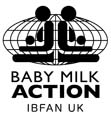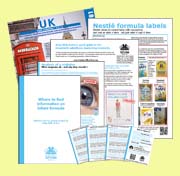Take a Break: a mother's pain - an editor's headline
 We have been contacted by many people about the lead headline on the cover of the current edition of Take a Break magazine: "Poisoned by Mum's milk: Breastfeeding KILLED by baby".
We have been contacted by many people about the lead headline on the cover of the current edition of Take a Break magazine: "Poisoned by Mum's milk: Breastfeeding KILLED by baby".
The headline is sensationalist - and misleading. The child had a rare genetic condition called Galactosaemia, which is an inability to break down lactose fully, making breastfeeding OR formula feeding dangerous.
Galactosaemia affects an estimated 1 in 45,000 babies in the UK every year - a fact mentioned in the article. In this particular case the child was both breastfed and fed on formula at night, but it is breastfeeding singled out by the editor as killing the child.
Understandably the headline has provoked a strong reaction. However, having read the article, my first thought is for the parents, who may not have known their story would have been presented in this way. The mother is named in the article and I would do so here, but for the strong reaction prompted by the cover. The mother says in the article:
"Sharing our experiences helped, and I began to realise that it wasn't my fault. I had simply done what I'd thought was best for my baby. If only he'd had his heel-prick test earlier, I would have put him on soya milk formula as soon as I'd known.... Now we're trying to raise awareness of galactosaemia, and I'm asking the NHS to consider heel-prick testing sooner."
For information from the glactosaemia society click here.
However, there is the danger that the sensationalising headline could be counter-productive if it discourages breastfeeding or encourages use of soya formula. Breastfed infants are less likely to suffer a whole range of short-term and long-term illnesses than formula-fed babies. The NHS spends an estimated £40 million a year treating the greater prevalence of just the three most common illnesses in formula-fed babies (see UNICEF UK's paper: Preventing Disease and Saving Resources). As mentioned above, babies with galactosaemia are also at risk from formula based on cow's milk. While soya formula is recommened in these cases, the Department of Health warns against it being used routinely. This page on the NHS site explains more about soya formula (let us know if the link dies).
The recommendation to exclusively breastfeed for the first 6 months followed by continued breastfeeding with the introduction of complementary foods continues to be true for the vast majority of babies. If that fact is obscured by the Take a Break headline, it would be a tragedy.
There is another aspect to this story that struck me when I saw some of the angry comments posted online about the cover. On reading the article, the intention of the mother is clearly to warn other women so they do not suffer in the same way she had done in trying to do the best for her child. It appears under the strapline: "A mum's guilt". This reminded me of the wishes of the mother in Pakistan who appears in the famous picture shown below.
 The mother breastfed her son while her daughter was fed on formula. This picture (left) was used in the UN Standing Committee on Nutrition journal with the explanation under the headline: "A mother's grief":
The mother breastfed her son while her daughter was fed on formula. This picture (left) was used in the UN Standing Committee on Nutrition journal with the explanation under the headline: "A mother's grief":
This picture tells two stories: most obviously, about the often fatal consequences of bottle-feeding; more profoundly, about the age-old bias in favour of the male. The child with the bottle is a girl - she died the next day. Her twin brother was breastfed. This woman was told by her mother-in-law that she didn’t have enough milk for both her children, and so should breastfeed the boy. But almost certainly she could have fed both children herself, because the process of suckling induces the production of milk.
"Use my picture if it will help", said the mother. "I don’t want other people to make the same mistake."
Babies are more likely to become ill if they are not breastfed and, in conditions of poverty, they are more likely to die. It is a shocking image and one we, like the UN, have used to raise awareness of the need for action. This continues to be essential: as Save the Children reported earlier this year, Nestlé and other companies continue to violate internationally agreed marketing standards in Pakistan and elsewhere. The mother clearly posed for this picture to illustrate her story and it is sometimes attacked as faked on this basis by those who find its message challenging.
 I am also reminded of Gloria (left), who took part in a demonstration in the Philippines in successfully defending regulations in 2007. She took her son Miguel with her, who she had fed on formula having believed advertising that suggests formula makes children more intelligent. The Philippines continues to need our support as Nestlé is currently attempting to have much of the protection provided by those regulations scrapped - click here.
I am also reminded of Gloria (left), who took part in a demonstration in the Philippines in successfully defending regulations in 2007. She took her son Miguel with her, who she had fed on formula having believed advertising that suggests formula makes children more intelligent. The Philippines continues to need our support as Nestlé is currently attempting to have much of the protection provided by those regulations scrapped - click here.
The hurt reaction to the Take a Break cover also reminds me of some of the comments we have received about images such as the Pakistan twins. It is a reminder of the care needed when we present these stories because they intrude into the lives of the readers in a sometimes challenging way.
Above all, I am struck by how the polarisation between breastfeeding and formula feeding in our culture does not serve us well. Mothers need to know about the risks of formula. They need to be aware of the importance of the heel-prick test and that the rare genetic disorder of galactosaemia puts a small number of babies at risk from the lactose in breastmilk and milk-based formula, while understanding that soya formula is not recommended for routine use.
We need to ensure there is access to accurate, independent information by removing the financial vested interests from infant feeding by finally implementing the World Health Assembly marketing standards in the UK. The UN Committee on the Rights of the Child has repeatedly called on the UK Government to do so - see our Look What They're Doing in the UK 2013 monitoring report for details.
Then we may find it easier for mothers to share what they have in common - wanting the best for their children - and learn from each others experiences.
Hopefully that will lead to fewer stories of mothers suffering grief and guilt because of lack of information.
- Webmaster's blog
- Login to post comments






